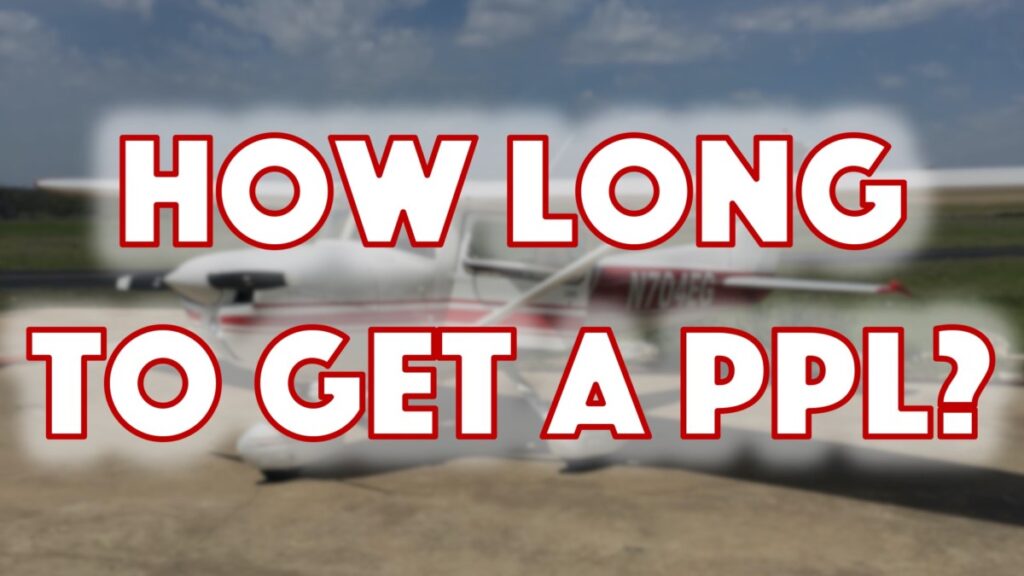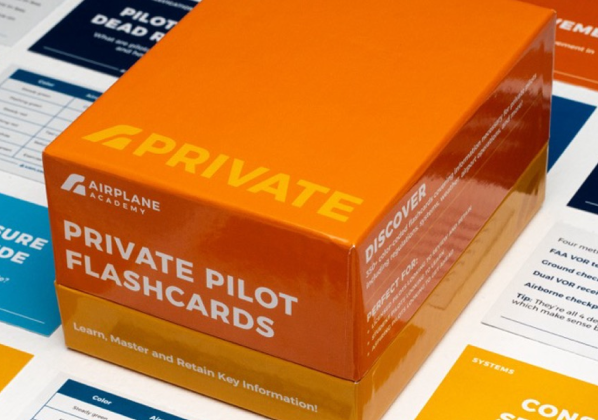
Flying has been a centuries-long sought after skill, and we live in such a unique time to be able to become pilots ourselves. For so long the idea of manned flight was just a dream, but now it is a reality and accessible to many. Not only is aviation a viable career opportunity with an increasingly attractive compensation range, it is also an amazing hobby for hundreds of thousands of people across the US.
Learning to fly an airplane is no small feat, though, and involves much training and financial investment to become licensed to fly. One of the most common questions asked before someone jumps into the world of aviation is how long does it take to get your private pilot’s license?
Earning your private pilot’s license requires 40 logged hours of flight training but on average takes closer to 60-70 flight hours. This training usually takes about 6-12 months if you take a flight lesson once every 1-2 weeks.
These numbers are just averages but based on my own experiences and other pilots I know, this seems to be a consistent estimate as to what it takes to learn to fly. The concept of “learning to fly” is a little loose in definition so let’s get into some more detail about what that actually looks like to become a private pilot including how your training is structured, what it will cost, and what you can do from there.
Also, for those of you starting your journey as a pilot, I put together a mini-library of 23 different resources and answers that I wish I could have consumed before I started flying or early in my training. You can grab that (for free) here:
Part 61 vs. 141 Schools
Requirements for your private pilot’s license differ based on whether you are training under a Part 61 or 141 flight school. In short, Part 141 schools have a more structured training regimen and must pass certain benchmarks with their student volume and pass rates, and as a result are able to graduate students in fewer flight hours.
Specific to the private pilot’s license, here are the Part 61 vs. 141 requirements:
| Part 61 | Part 141 | |
| Minimum Flight Hours Before Check Ride | 40 | 35 |
| Solo Hours | 10 | 5 |
For more on this topic, see our article on Part 61 vs. 141 Flight Schools – Requirements and Differences.
The Start of Training: Average Time Until Your First Solo Flight
You will be a student pilot until you take and pass your check ride, at which point you will be a certified private pilot. As a student pilot you are not allowed to carry passengers without an instructor, but fairly early on in your training your instructor will certify you to fly by yourself.
This solo flight usually happens at around 15-20 hours into your training but will vary from student to student. It is a truly amazing moment to look around the airplane and realize that no one is flying the airplane but you (If you’re about to solo, make sure to read our 9 Foolproof Tips for Your First Airplane Solo). At that flight, you’ve earned your wings and enter a unique club (as proof, the tradition is even to cut your shirt tail off when you land – you’re in!).
After that point, about half of your training will be done with the instructor, and half will be completed solo. There are certain missions (such as a cross country, night cross country, solo cross country) that you will need to accomplish and have in your logbook before you can qualify to take your final check ride and be a certified private pilot.
So technically you will “learn to fly” an airplane within the first few hours of your training, and even fly by yourself shortly thereafter. However you won’t be able to carry other passengers quite yet.
Second Half of Training: From Solo Flight to Check Ride
Once you solo you’ll probably have another 20-35 flight hours or so of training to go, but it will largely depend on how quickly you progress through the concepts and material.
Flight lessons usually last between 1-3 hours (most on the lower end of that unless you’re doing some cross country work), and count on having an hour on both sides of that for pre and post-flight briefings with your instructor. For some people that means they will only be able to do it on the weekends, so flying once per week is pretty average if you are doing this on the side.
The more often you fly the less you will have to repeat lessons and concepts and will make your training more efficient. If you are doing a full-time training program you can probably complete your entire license in a matter of weeks.
Training Curriculum
When you first start out, you will be learning the basics of flight: turns, climbs, descents, and power adjustments. All other flight maneuvers and tasks use these four principles in some combination or another.
You’ll then progress into more complex iterations of those four principles, such as steep turns, turns about a point, S-turns, and stall recovery. That will give you a good base of maneuvers to then start practicing different types of takeoffs and landings.
From there you will conduct a solo flight, after which point you start to get into more cross-county type flying which involves learning about navigation, radio skills, night flight, emergency procedures, and more. The whole curriculum just slowly builds on itself until you are a well-rounded student pilot and are ready for your FAA check ride.
At some point in your training (I preferred to do this first with any rating I have done) you will need to take your written test. Some flight schools will hold an intensive ground school weekend where it’s three eight hour days, covering all of the base knowledge you’ll need to pass your written test.
Everyone is different but I have done this type of program for my private, instrument, and commercial licenses and always found it far superior than self-study alone. You’ll need an instructor’s endorsement that you are ready to take the written test anyways, and these in-person ground schools will usually provide that endorsement at the end.
If you are studying remotely and don’t have access to a ground school such as this, I highly recommend King Schools curriculum. John and Martha have been teaching for a very long time, and while some might find their video material to be a bit corny, the material and teaching methods are sound and they have graduated a lot of pilots through their courses over the year. I did this for my commercial written (in addition to the intensive ground school) and got an A on my written test. It’s a great way to study remotely.
At the end of your training you will have your check ride with an FAA examiner that will comprise of an oral exam (usually 1-2 hours in length) followed by a flight test (also 1-2 hours in length). It’s definitely a stressful afternoon but it’s the only way to get your license. Study enough and you will be fine.
The good news is that you know exactly what they need to cover and test you on before you ever take the check ride, and it’s called the ACS or Airman Certification Standards. You can download this online for free (or there are supplement books and study guides based on the ACS that are very affordable and available on Amazon) and be fully prepared when you take your check ride. Again, on average pilots will have 60-70 flight hours before reaching this point but you technically only need 40 as long as you have achieved the required flight experience within that 40 hours (such as certain cross country time, night flying, etc.).
Average Cost of Getting Your Pilot’s License
Between the airplane rental, instructor fees, testing fees, and gear, the private pilot’s license costs on average about $10,000 to obtain. We wrote a pretty thorough post on “How much does it cost to get a private pilot’s license?” so be sure to give that a read if you want the more detailed breakdown.
A sport pilot’s license which has many limitations (such as airplane size and horsepower, flight into instrument conditions, and nighttime flying) is more affordable and is on average about $5,000 to obtain. You’ll need only half the required hours vs. the private pilot’s license but again that is because the sport license is more limited in nature and so the training does not cover as much (since you won’t be allowed to do as much).
Ways to Decrease Time and Cost of Getting Your Pilot’s License
We cover this in more detail in this post but here is a snapshot of ways you can try to reduce the cost of the pilot’s license:
- Fly regularly so you don’t have to repeat lessons (this is the biggest thing you can do… fly often)
- Buy flight hours in bulk to save
- Choose a smaller or less advanced airplane to train in, as the rate will be lower
- Take a ground school intensive or weekend course to speed up training and finish your written test
- Self-study using the ACS, ACS study guides, and YouTube (there is a lot of amazing, free, content on YouTube nowadays)
- Go rural – flight training will cost less in less congested areas but this does have its downsides like not learning how to fly in busy airspace or getting comfortable with air traffic control
- Borrow gear before you buy it – don’t buy a headset at first and that can save you up to $1,000 or more (although I strongly encourage you to invest in the best headset you can buy like the Bose A20 or Lightspeed Zulu).
Beyond the Private Pilot’s License
Once you become a private pilot, there are several other ratings and licenses you can get that will be beneficial (if not required) for what you want to do in aviation (even if it’s just a hobby). Here is a quick overview:
Instrument rating
If you want to fly into limited visibility (like clouds, fog, or the like) you will need your instrument rating. This is a really fun and challenging rating where you spend 40 additional flight hours with a view-limiting device so that you can’t actually see outside the airplane and have to rely solely on your instruments.
It’s a pretty exhausting rating but you will come out of it a much safer, well-rounded pilot. This averages about another $10,000 in training costs but again can be lowered by training more often, buying bulk hours, and self-studying as much as you can to avoid repeat lessons.
Commercial Rating
If you want to be paid to fly, you’ll need a commercial rating. This is a relatively easy rating compared to the private and instrument, and is largely just based on demonstrating new flight maneuvers that you didn’t learn as part of your private training. The commercial license is broken out into single and multi-engine licenses and so you’ll need a commercial for whichever class of airplane (single land, single engine sea, multi-engine land, or multi-engine sea) you plan to be paid to fly.
For more reading, see our post on how long it takes to earn you commercial rating.
Multi-Engine Rating
This is pretty straightforward – learn to fly airplanes with more than one engine! This is probably one of the easier ratings as pretty much the entire training regimen is based on what to do if one of the engine quits in any phase of the flight (takeoff, climb, cruise, descent, approach, and landing). This can be done in a matter of a few flight hours and is not overly expensive to achieve (about $3,000 on average).
Certified Flight Instructor
Want to teach? You’ll need your CFI. This is segmented into different types of flight instructor ratings, such as your basic CFI, CFII (instrument instructor), MEI (multi-engine instructor), and others. This is a pretty hard rating to get as you not only have to understand the material thoroughly, but you have to learn how to teach it.
You don’t just need to be able to perform the maneuvers from the co-pilot’s seat, you have to be able to coach students on what they are doing wrong and efficiently coach them into doing it correctly. This can be one of the most rewarding things you ever do in aviation though and can be an amazing way to give back to the flying community while also getting paid.
Airline Transport Pilot
At 1,500 hours you can qualify to get your airline transport pilot license. This isn’t all that hard but the minimum hour requirement can take a while for new pilots to achieve. The check ride mostly consists of flight maneuvers that have very little tolerances for error on altitude deviations.
The concept here is to have total mastery over the aircraft in all flight maneuvers and procedures. As such, the license is split out into single engine ATP and multi-engine ATP, similar to the commercial rating. Most airlines will require you to have your ATP or at least be eligible for your ATP upon hire.
If you aren’t planning on flying professionally, the ATP is nothing more than a cool trophy on the wall, but some choose to get it for that reason alone.
For more reading on this, see our article comparing private pilot, commercial pilot, and ATP certificates.
Seaplane Rating
This is the most fun 4.5 flight hours I have in my entire logbook. Learning to land on water is unlike any other flight experience I’ve ever had. This is a pretty easy rating to get and arguably the shortest from a training hours perspective. Plus, it’s loads of fun. I got my seaplane rating in Alaska and the experience was a once in a lifetime thing. Highly recommend!
In case you missed it above, you can grab my Ultimate Starter Guide to Your Aviation Journey below. It’s packed with 23 different resources I wish I could’ve consumed before or early into my flight training. It’s totally free and jam-packed with actionable, practical content for you as a new aviator or someone exploring their license.
Conclusion
That was a little more expansive than just how long it takes to learn to fly, but hopefully this gave you a realistic overview of what training would look like to become a private pilot, as well as what your aviation pursuits might look like after that point. It’s been one of the most rewarding things I have ever done and has changed my perspective on life.
I love the quote from Leonardo Di Vinci in the year 1500 (400 years before manned flight was achieved!) telling other people why his flying inventions and pursuits were legitimate: “Once you have tasted flight, you will forever walk with your eyes turned skyward, for there you have been, and there you will always long to return.”
Blue skies!



